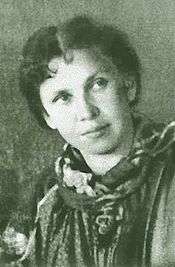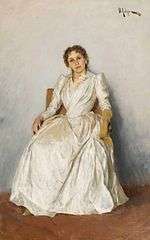Sofia Kuvshinnikova

Sofia Petrovna Kuvshinnikova, née Safonova (Russian: Софья Петровна Кувшинникова; 1847 - 1907, near Moscow) was a Russian landscape painter. For many years, she was the mistress of Isaac Levitan and served as the inspiration for the lead character in a short story by Anton Chekhov: Попрыгунья (The Grasshopper, 1892). In 1955, it was adapted for the screen as the first movie directed by Samson Samsonov, with Lyudmila Tselikovskaya in the starring role.
Biography

She was born to the family of a minor civil servant. After an education which stressed the fine arts, she married Dr Dmitri Kuvshinnikov, a doctor for the police department who was much older.[1] In 1871, he appeared as one of the figures in a painting by Vasily Perov ("The Hunters at Rest").[2] This was exhibited at a showing by the Peredvizhniki and, afterwards, his modest apartment became a gathering place for the creative community; a group which came to include Levitan and the Chekhovs.

Sofia acted as hostess and, for many, was considered one of the chief attractions there. She not only played piano and sewed costumes, she often went out hunting, dressed as a man, and brought back a full bag of game.
In 1886, the Chekhov brothers introduced Levitan to the Kuvshinnikovs. Levitan considered himself to be a "ladies' man"[3] and he soon fixed his sights on Sofia, although she was thirteen years his senior. Often, he would bring his art materials and paint while she played piano.[1] In 1888 he, Sofia, and Alexei Stepanov took a steam trip on the Volga. They found themselves attracted to the town of Plyos and decided to stay. They remained until 1890. It was there she studied with him and improved her amateur painting skills.[4]
.jpg)
The Grasshopper dates from shortly after this time. Chekhov published the short story in The Performing Artist. The story concerns a lecherous man who has an affair with a wife leaving her innocent husband to destroy himself. Levitan and Kuvshinnikova were both offended although the central figure in the story was a young wife and Kuvshinnikova was 42. Moreover she was dark and a talented painter and Chekhov's character was blond and not an artist. The stronger similarity was that her husband Dr Kuvshinnikova was tolerant of her disloyalty to him as was "The Grasshopper" who forgave his wife's indiscretions.[5] She, Levitan and her husband travelled together and were considered a ménage a trois.[3]
Chekhov was a close friend of Sofia's and may have had strong affections for her. The story was a way of criticizing her betrayal, both of him and her innocent husband, and created a small scandal. According to the memoirs of Chekhov's brother, Mikhail, the situation almost led to a duel with Levitan, but it was avoided thanks to the intercession of a mutual friend, Tatiana Shchepkina-Kupernik.[6] Nevertheless she and Chekhov were no longer friends. Her husband's understanding was illustrated in the help he later gave to Levitan. He and his family like all Jews were being expelled out of the city. It was Dr Kuvshinnikov who interceded with the authorities to allow his wife's lover to return.[5]
It is unclear if there was ever a formal separation from her husband but, in 1894, she and Levitan settled at an estate on Lake Ostrovno in Tver Oblast. Before long, he began another affair with a younger woman from a neighboring estate and she returned to Moscow. They reconciled and broke up twice more; in 1895 and 1897.[4]
From then on, she pursued her own career as a painter and maintained friendships with numerous artists, writers and performers. In August 1907, she was visiting friends at an estate near Moscow, when she fell ill with dysentery and died.[7]
References
- 1 2 Brief Biography @ Знаменитые женщины.
- ↑ "Who are the Hunters at Rest?" by Yuri Volgin @ the Chuvash Republic website.
- 1 2 Donald Rayfield (1998). Anton Chekhov: A Life. Northwestern University Press. pp. 221–225. ISBN 978-0-8101-1795-2.
- 1 2 Biographical notes and works from the Museum of Landscape, Plyos.
- 1 2 Donald Rayfield (1998). Anton Chekhov: A Life. Northwestern University Press. pp. 269–. ISBN 978-0-8101-1795-2.
- ↑ "Why, because of his beloved, did Levitan almost call a duel with Chekhov?" by Vladimir Rogoza @ Школа Жизни.
- ↑ Obituary @ Газетные старостей.
See also
External links
| Wikimedia Commons has media related to Sofia Kuvshinnikova. |
- "Dr. Dimov of Grasshopper. A Story of medical heroism" by Alexei Mitrofanov @ Miloserdie.